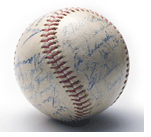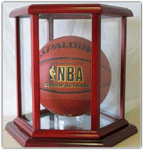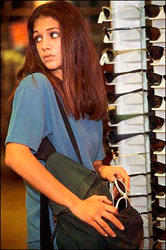Creating an ePedigree for sports collectibles with RFID
 With well more than half of all autographed items likely fake, memorabilia dealers are turning to technology for help
With well more than half of all autographed items likely fake, memorabilia dealers are turning to technology for help
By David Wyld, Contributing Editor
The business of sports has grown rapidly worldwide. According to the most recent report from the Sports Business Journal, the size of the American sports industry has reached an astonishing US$213 billion annually and the global market has been estimated to be close to a trillion dollar market. One Canadian media analyst has labeled our passion for sports as our new societal obsession, which he terms “sporno” (the idea that athletes and sport are the new pornography).
The market for sports collectibles has grown as a byproduct of this increased focus on professional sports and sports stars. It represents a significant part of the over $10 billion retail collectibles market – market that serves approximately 50 million collectors in the United States alone. In the past, sports memorabilia was purchased mostly at large trade shows or on a private sale basis. Today however, the sports collectible market has burgeoned into a part of mainstream online and offline retailing, with product available in a wide variety of venues, from eBay to your local mall.
Today, you can walk into almost any mall in the country and find a small shop dedicated to selling sports-themed collectibles, including items such as LeBron James’ autographed photographs, Indianapolis Colt’s helmets signed by Peyton Manning, and baseballs signed by everyone from Albert Pujols to Barry Bonds. Teams and leagues are getting in on the action themselves, selling autographed items and “game worn” uniforms both in the stadium and on the web.
However, the sports collectibles marketplace is perhaps the ultimate caveat emptor arena. According to FBI statistics, at least 70% of all autographed sports memorabilia is fraudulent and an estimated half-billion dollars is lost annually to fake sports collectibles in the U.S. The field is ripe for counterfeit items due to both the growing demand and the limited supply of genuine autographed and game-used items.
Despite the apparent ease of creating fake sports collectibles, especially given the powerful computing and printing technology at our fingertips, sports counterfeiting has become something of an art form. In fact, the majority of counterfeit sports memorabilia distributed across the United States can be traced to a finite number of counterfeiters. However, these rogue operations supply an enormous amount of high-quality fake memorabilia. These counterfeiters usually sell the fakes to large-scale distributors of sports collectibles, who in turn supply the items – knowingly and unknowingly – to major retail outlets, other smaller distributors, or directly to the public. These distributors – and ultimately the variety of retail outlets – are cognizant of the “fuzziness” of their supply chain.
How can RFID work to authenticate such items? There are several companies today vying to market RFID-based solutions for sports memorabilia, but the leader in the field to date is the Irving, Texas-based Prova Group, whose business model is to use RFID technology to be a third-party authenticator of the genuineness of sports collectibles. One of the founders of Prova is Emmitt Smith, the Hall of Fame running back who led Dallas Cowboy teams of the 1990s to three Super Bowl victories. His involvement not only provided the start-up with needed capital, but links to star athletes and teams in the NFL and other professional leagues.
The Prova system works by having a tamper-proof RFID tag applied directly on the surface of the collectible to be autographed by an athlete. Then, at the point of signing, the Prova system records the exact time of the signature to the second, when the item (a ball, a jersey, a helmet, etc.) is placed within 12 inches of an antenna set up near the athlete’s hand. The autographer’s secure identification code is written to the tag, recording who signed as well as when and where the signature occurred. The data for this unique item is recorded in Prova’s online registry.
By accessing the item in Prova’s database via the Internet, the collector or subsequent prospective buyers can access an item’s history and view an undeniable “chain of custody” from the creation of the autographed item. Likewise, sports teams are using Prova RFID tagging systems to verify the authenticity of “game worn” uniforms (such as jerseys and helmets) and balls.
The company already has deals in place with the Dallas Cowboys and St. Louis Rams to tag each jersey worn by their players in NFL games. The Prova system then tracks the time at which the uniform is logged in and out for use in each game. For instance, the purchaser of the “game worn” jersey of Reggie Bush could verify that the wide receiver wore it in the team’s October 15, 2006 game versus the Philadelphia Eagles. Thus, in addition to being able to print a hard copy certificate of authenticity, a collector could direct prospective buyers of that item to the firm’s online registry for verification of the game use of the jersey. Craig Noonan, Prova’s Chief Marketing Officer, observed that by marking collectible items with RFID and providing an online registry, “we give you a way to track an item’s ownership history similar to a title search on a house … we’re protecting authenticity from generation to generation.”
The sports memorabilia marketplace is at a crossroads. With more and more interest in sports on a global basis and with sports stars commanding more and more attention, the market prospects for sports collectibles is bright. As new sports and new stars emerge to take center stage, ala the rise of NASCAR and extreme sports, there are whole new generations of sports fans that will create new opportunities for sports memorabilia. However, the wave of counterfeit items threatens chaos in the market. With today’s technology, RFID can be a tool to add an indisputable assurance of authenticity to sports collectibles, enabling buyers and sellers alike to work with an e-pedigree for memorabilia and fostering even greater growth in the global market for these items.
About the author:
David C. Wyld ([email protected]) is the Robert Maurin Professor of Management at Southeastern Louisiana University, where he directs the College of Business’ Strategic e-Commerce/e-Government Initiative and teaches business strategy.




